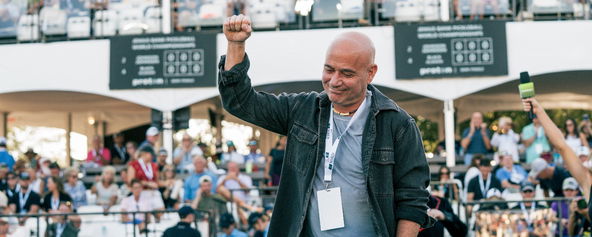
Close Call Replay highlights the need for clearer line call guidelines in pro pickleball
Line calls have always been a point of contention in pro pickleball.
I come from a tennis background, so my first instinct is to call the ball “in” if it looks like any part of it catches the line.
That rule can’t apply in pickleball, though, because only a small part of the ball actually touches the ground upon landing. Pickleballs also don’t compress on impact, which makes it more difficult to decipher where the point of contact is without line cameras.
For a long time, there wasn’t much access to those cameras—or accurate replay systems—at PPA events. That was most recently remedied in early September, when the United Pickleball Association of America brought in Close Call Replay, which boasts line cameras recording at 240 frames per second.
This tool has prompted the UPA-A to roll out new rules and guidelines for referees and players regarding line calls.
One of the most important—and controversial in practice, thus far—is the 75% Rule.

ADVERTISEMENT
This rule states that a ball is only “out” if at least 75% of it is beyond the baseline or sideline when it lands on the court. In other words, if more than 25% of the ball appears to be touching either line at the point of contact, then it should be considered “in.”
There are some obvious issues here. At the forefront is the fact that the rule relies on referees to accurately determine how much of the ball is or isn’t touching the line.
It’s a difficult task that, most problematically, is prone to significant variance from person to person.
That specific challenge has been painfully apparent within the first few weeks of this rule going into effect.
In an MLP New York City match featuring the Chicago Slice and Las Vegas Night Owls, Chicago’s Allison Harris hit an ATP on match point that was called out by Las Vegas.
The replay revealed the ball’s point of contact to be outside of the line, prompting commentators Ryan Dawidjan and Carolyn Penner to predict that the initial “out” call would stand.
Thanks to the 75% Rule, however, the call was overturned, and the ball ruled in.
Let’s take a closer look.

I would say that approximately 80% of the ball is to the left of the sideline, which would make an “out” call appropriate. But the referees saw it the other way and called it “in.”
The fact that I see this differently than the referees did is completely fine; what isn’t fine is that a decision like this line call is left up to an individual’s interpretation of the review.
We got a similar situation just a few weeks earlier at the CIBC Atlanta Slam, the first PPA event with Close Call Replay capability.
This one occurred in the men’s doubles semifinal pitting Jaume Martinez Vich and Tyson McGuffin against JW Johnson and Dylan Frazier.
Again on match point, Martinez Vich hit a backhand speedup that landed extremely close to the back of the baseline and was initially called “out” by Frazier.

The ball was ruled “in” after review, overturning another “out” call in a decision that I actually agree with based on the 75% Rule.
Like in the previous example, the ball’s point of contact appears to be just beyond the baseline, but I think the slowed down view shows that more than 25% of the ball is over the line upon landing.
Of course, you might come to a different conclusion than I did.
Still, the overarching issue of variance in individual interpretation remains. Frazier was visibly shocked when his call was overturned, and commentator Adam Stone said on the broadcast that he also thought the ball was “out” after seeing the replay.
There’s no denying that having Close Call Replay at PPA and MLP events is a major step up for pickleball, but the current guidelines for interpreting what those cameras are showing us are only leading to more confusion and frustration among players and fans.
We finally have close call replay and we’re still finding a way to blow calls with this new 25/75 rule 😂
— Zane Navratil (@ZaneNavratil) September 22, 2024
What do you think is the best solution going forward? Let us know on social media.
Related articles

UPA hands Parris Todd two-event suspension, $50,000 fine
The $50,000 fine matches the highest amount that the UPA has ever fined a player for a single infraction.
15 hours ago
-Pickleball.com Staff

Fahey featured in SportsCenter’s ‘Year in Review’ piece
Pro pickleball continues to make appearances in mainstream media.
3 days ago
-Pickleball.com Staff

Andre Agassi urges players to raise their fashion game
The tennis legend stunned the world with his denim looks, and now it’s time to bring that same energy to pickleball.
3 days ago
-Victoria Radnothy
.jpg?width=592&height=237&optimizer=image)
Looking back on the best moments from the 2025 MLP season
There was no shortage of memorable highlights this year.
7 days ago
-Will Daughton





